AMD EPYC 3451 Market Positioning
Thes chips are not released in a vacuum instead, they have competition on both the Intel and AMD sides.
AMD EPYC 3451 v. Intel Alternatives
The AMD EPYC 3451 is interesting because it was technically launched in Q1 2018, but volume shipments happened in Q4 2019. As a result, we wanted to update some of the charts from our Exploring Intel Xeon D Evolution from Xeon D-1500 to Xeon D-2100 piece with the series. In that piece, we showed how the Xeon D-1500 series “waves” of CPUs launched and how the Xeon D-2100 series compared across a number of vectors. Since that piece, there is higher clock speed and TDP up to 8-core Intel Xeon D-1600 series that traded power consumption and core counts for higher clock speeds on the Broadwell-DE base platform.
Here is what the story looks like in terms of average and max core counts over the four waves of Xeon D-1500 launches along with the Xeon D-2100 series and the EPYC 3001 series:
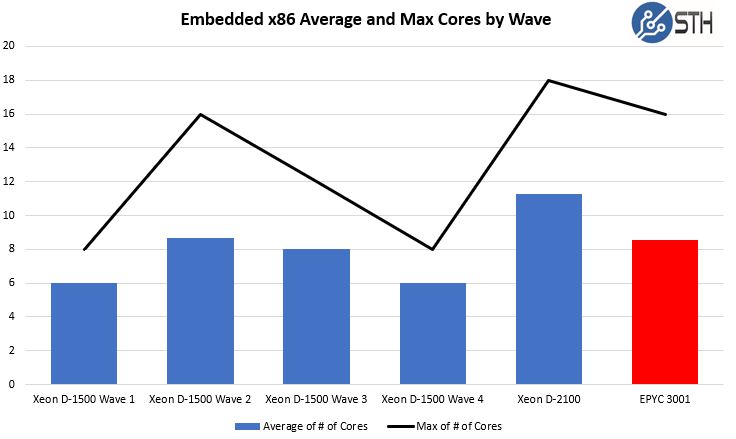
As you can see, the AMD EPYC 3001 series was designed to be a competitor in many ways with the Xeon D-1500 Wave 2 parts in terms of core counts. The Xeon D-1500 series has been extremely successful outside of its primary hyper-scale client (Facebook) so it makes sense that AMD is targeting that range.
Something that we see the EPYC Embedded 3001 series has is relatively higher clock speeds than the Xeon D-1500 series. The Xeon D-2100 series is designed as a higher-power part, and so we see maximum clocks reach higher numbers there.
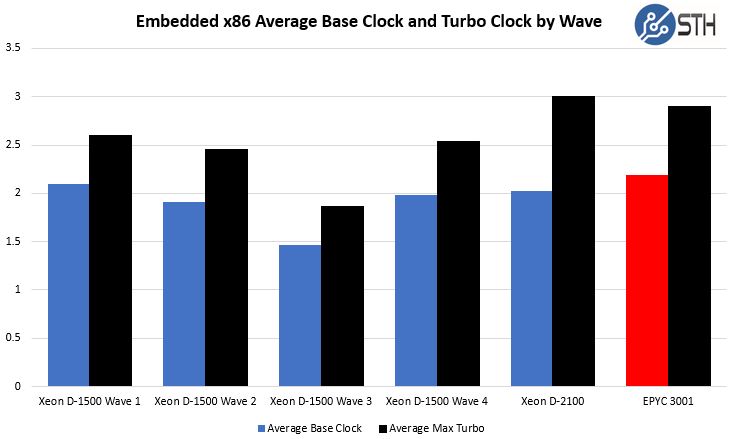
When we look at the average, min, and max TDPs, we can see segmentation fairly clearly. Many segments of the embedded market are highly TDP sensitive, so having a wide range of options is important. AMD is effectively scaling from bottom of the Xeon D-1500 range up to the top of the Xeon D-2100 range with its seven SKU lineup.
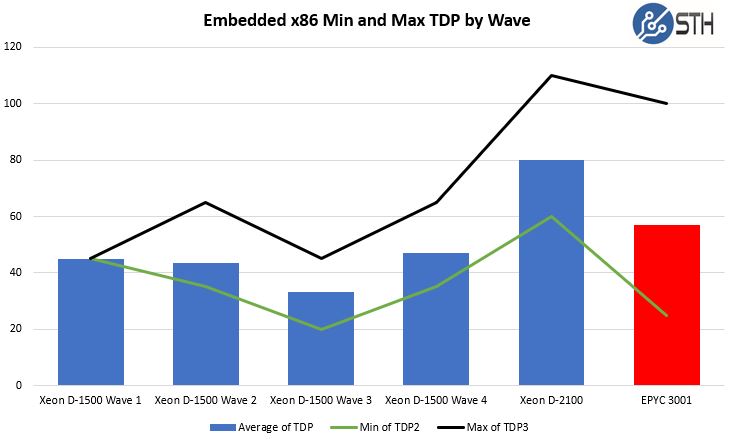
On the price side, we can see something that was started in the AMD EPYC 7001 series “Naples” launch. AMD’s multi-die approach means that the higher-core count SKUs are not extraordinarily more expensive. AMD is adopting a lower list price model to enter the market. Not only are the list prices well below the Xeon D-2100 series, but they are below the Xeon D-1500 series as well.
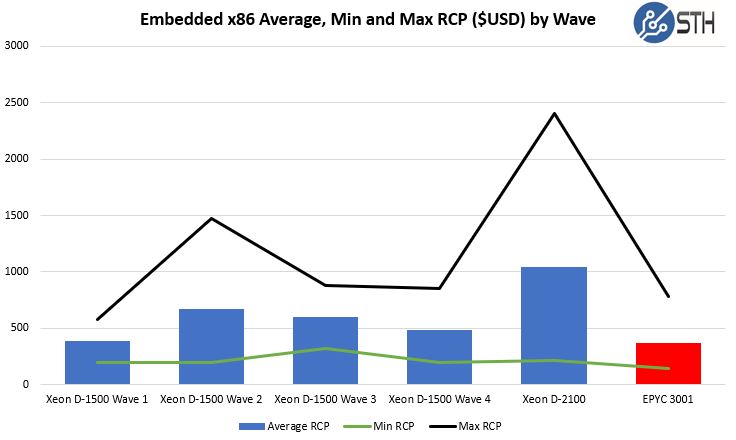
That was a fairly circuitous route to get to the key takeaway: the AMD EPYC 3451 is really not specifically targeted as a Xeon D-2183IT competitor. In many workloads, the performance is close and sometimes the EPYC 3451 can show faster numbers.
In this market, it is more than just about one SKU and the range of SKUs matter. The AMD EPYC 3001 embedded series is really designed to go head-to-head with the Xeon D-1500 series where features such as onboard QAT acceleration are not needed. If you are not using QAT which many of the Xeon D-1500 SKUs do not support, then the EPYC Embedded 3001 series is going to cover largely the same range of applications. It is an x86 part that is based on the same core as a popular desktop and server architecture so at this point, OSes just work on AMD. Many OSes and applications also do not have to add the same workarounds for current speculative execution vulnerabilities that are needed on the Intel side. As a result, the AMD EPYC 3001 of today, in a way, can run OSes and applications closer to what we saw in 2015 with Xeon D.
The EPYC 3451 offers other advantages that the Xeon D-1500 series, and even the Xeon D-2100 series cannot match. It has more PCIe Gen3 connectivity for modern NVMe storage, NICs, and accelerators. It is providing this all at around half, or less, of the price of Intel’s 16 core competition. Those are important for embedded systems designers.
Value and performance aside, for those who have been using only Xeon D, it may be time to look at the AMD EPYC 3451 and its stablemates as an alternative. That gives more supplier diversity for your supply chain, and also allows for risk mitigation should another major security flaw present itself with either Intel or AMD architectures. A major advantage here is simply that one does not have to port code to use AMD as one would with Arm to get this kind of supplier diversity.
AMD EPYC 3451 v. AMD Alternatives
Here is what the AMD EPYC 3451 looks like compared to the other SKUs in this family:

As you can see, it occupies the highest-end spot with the most I/O available in the platform at the cost of having the highest TDP and sacrificing some clock speed.
The AMD EPYC 3451 is very interesting for another reason. As a $778 part, it is only $48.63 per core which is in line with other offerings in the stack:
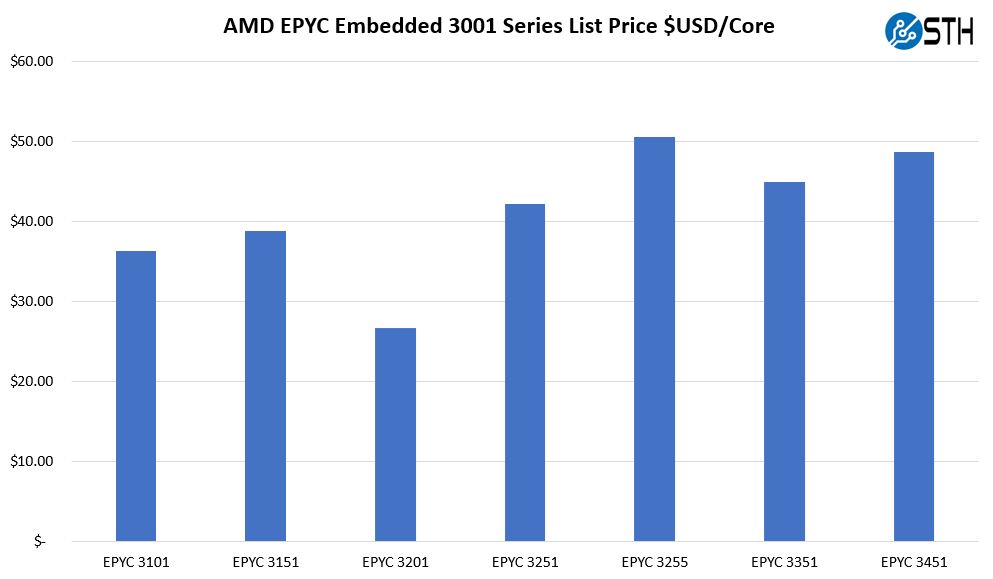
In fact, while Intel is charging a large premium for 16 core Xeon D parts over its socketed mainstream alternatives, AMD is offering a discount. The single-socket AMD EPYC 7302P is around $51.60 per core. Those chips play in a very different market segment, however, The Xeon D-2183IT costs more than the Intel Xeon Gold 6226R. While Intel is extracting a large premium for more cores in this space, AMD is making it relatively cost-effective to scale up to higher core count parts such as the EPYC 3451 from its lower core count offerings without a huge premium.
As a result, we think that the biggest decision within the AMD portfolio comes down to the right form factor, TDP, core count and I/O mix rather than metrics such as cost per core premiums that are common in our other market positioning discussions.
Final Words
This was perhaps the part that I was most excited about walking out of the launch event on that cold February day in London. Finally having the opportunity to test the solution, albeit two years later, is certainly exciting.
The next step is perhaps the more important one. Some OEMs and systems vendors have started to adopt these higher-core count parts, but we need more platforms. I am saying this selfishly as I personally want a platform that exposes the 8x 10GbE NICs, and all 64 PCIe lanes (no need for SATA in 2020) with the AMD EPYC 3451. Upgrades to the higher-end of the Xeon D range to this level of performance are simply too costly for where we use them in our infrastructure. Just as AMD EPYC 7002 “Rome” CPUs brought competition to the mainstream server CPU space, we need the EPYC 3001 series to disrupt the pricing models in the embedded space.
With the EPYC 3451, AMD now has a high-performing 16-core embedded part that offers more I/O and security features at a significantly better value. The next step is that we need to see them in the market.




The market analysis vs Intel is great. I’d skip the benchmarks and go there after the first page.
Love to see these. Like you said, there needs to be more platforms. And someone to actually take advantage of all the expansion capability. I’d like to see Supermicro do a v.2 that does that…
I like to see this AMD EPYC 3000 SoCs in product like Supermicro Flex-ATX boards since I first read about them in 2018.
We use especially the X10SDV-4C-7TP4F (4Core Xeon-D) for edge storage servers, because this boards are small enough for short depth 19″ cases that fit into short depth network gear cabinets.
Furthermore, I like them for the low power consumption.
I know there are cheep NAS boxes that also fit into small recks, however this Xeon-D Flex-ATX boards are way more flexible, reliable and powerful (think of clients working while a RAID set need to be scrubbed, rebuild, backuped and so on). It is possible to connect up to 16 SAS drives without requiring a SAS expander.
We also run Mail-Servers, SAMBA as a directory controller and Free RADIUS for VPN and WiFi access management on it.
Why not mini-ITX? Because it is not possible to have an SAS controller and SFP+ nic on a mini-ITX board (only on PCIe slot!).
The Supermicro X10SDV-4C-7TP4F has both onboard and provide 2 PCIe slots for further expandability!
I have already seen mini-ITX boards with 10GBase-T interfaces. While this would allow 10Gbit/s network connection together with a SAS HBA on a mini-ITX board, it is usually not very practical because a lot of 1G edge switches have 2 or 4 SFP+ ports. However, I don’t know a single 24 port 1G switch with a 10GBase-T interface. Furthermore, I think SFP+ is in general more flexible and cheeper then 10GBase-T. Therefor, I would really like to see mainboards for AMD EPYC 3000 series CPUs that exposes the included 10Gbit/s networking as SFP+ ports.
I often think about using Supermicro Flex-ATX boards with higher core counts for small 3 node Proxmox HA clusters. However, the boards with 16 core Xeon-D CPUs are too expensive compered to single socket EPYC 7000 servers. Furthermore, they are hardly available. The EPYC 3451 could be a game changer for this. We could probably fit 3 servers with EPYC 3451 CPUs in one single short depth rack. With at least 4 SPF+ interfaces we wouldn’t even need a 10Gbit switch for inter-cluster network connection, because we could simply connect every node to all the other ones directly!
I really hop I can read I review about a small AMD EPYC 3000 mainboard with SFP+ ports on STH soon.
Thanks to Patrick for his great work!
Why use such an old kernel (4.4) vs a newer (maybe have optimizations) kernel (5.x)?
Rob, that is just the software code that we are compiling. We are more likely to add another project such as chromium or similar as a second compile task. We are getting to the point where the kernel compile is so fast that we need a bigger project. That is even with the fact we compile more in our benchmark than many do.
EPYC3451D4I2-2T
https://www.asrockrack.com/general/productdetail.asp?Model=EPYC3451D4I2-2T#Specifications
Nearly one year since this post and we’re unable to buy any platform rocking a 3451 🙁
Getting close to 2 years, and still cannot get a system with 3451, or even other 3000 series ones with all the 10Gbps PHYs exposed, and all the PCIe lanes in small form factors (i.e. to two or three OCP 3.0 connectors would be nice option for example – for 25Gbps nic) . All the solutions I found only exposed very small subset of functionality of this SoC, and are super overpriced for what they provide. There is technically asrock rack, but still I am not able to order it, and it still uses Intel NIC to do networking, which is silly. I asked asrock rack and supermicro, and they said they are “working” on it, but still nothing in sight.